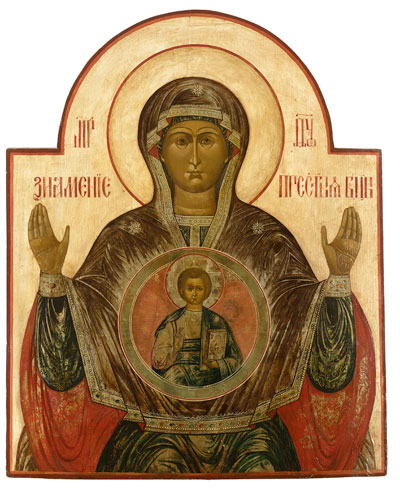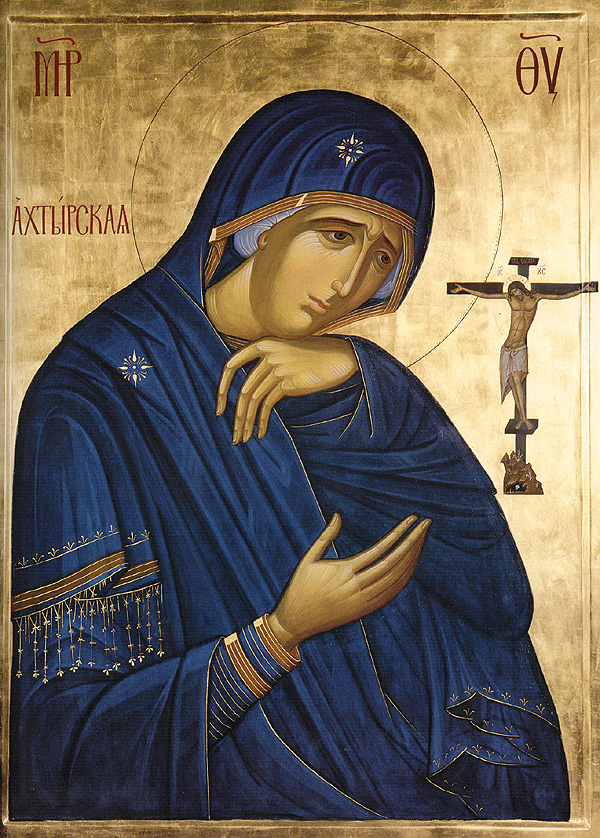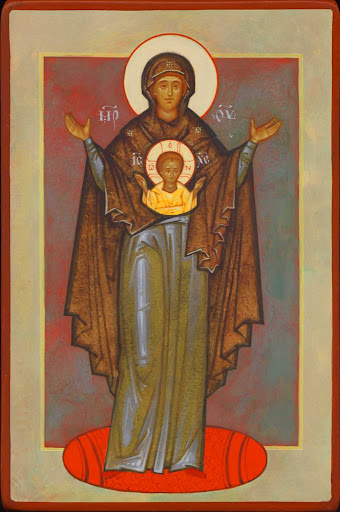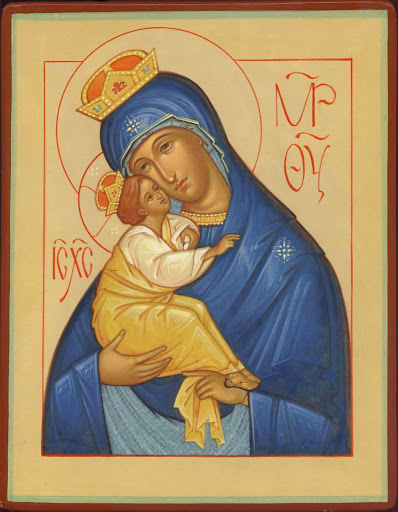 One of the tasks that those who are interested in cultural renewal have to face today is one of reawakening to the symbolism of the cosmos. This faculty can be stimulated, I believe, by incorporating a language of symbolism into art. I have written before of how when painting today, the artist has to decide on a case by case basis which symbols to revive and which to ignore (see Pelican Brief - Should We Aim to Revive All Christian Symbols of Sacred Art). A symbol must speak to those who are meant to see it and some symbols are so rooted in a culture that is bound to a different time and place that it is unlikely ever to communicate much to any nowadays but learned art historians.
The symbols that seem most prevelant and useful are those that are based on scripture or tradition and furthermore speak naturally of what they are trying to convey. These are the ones that I tend to focus on. So while the halo represents the uncreated light of sanctity it is not an arbitary symbol. It is as much a stylised representation of light eminating from the person.
One of the tasks that those who are interested in cultural renewal have to face today is one of reawakening to the symbolism of the cosmos. This faculty can be stimulated, I believe, by incorporating a language of symbolism into art. I have written before of how when painting today, the artist has to decide on a case by case basis which symbols to revive and which to ignore (see Pelican Brief - Should We Aim to Revive All Christian Symbols of Sacred Art). A symbol must speak to those who are meant to see it and some symbols are so rooted in a culture that is bound to a different time and place that it is unlikely ever to communicate much to any nowadays but learned art historians.
The symbols that seem most prevelant and useful are those that are based on scripture or tradition and furthermore speak naturally of what they are trying to convey. These are the ones that I tend to focus on. So while the halo represents the uncreated light of sanctity it is not an arbitary symbol. It is as much a stylised representation of light eminating from the person.
In contrast colour symbolism is more arbitrary. In fact no strict colour code of symbolism for any of the liturgical traditions, including even iconography (perhaps surprisingly). That is not to say that artists have not chosen colours in order convey spiritual meanings, and temporary trends can develop when artists are influenced by others in their choice. However, it is very difficult to find any colour symbolism that is observed consistently either across different traditions or even within one.
 Occasionally I am presented with a colour symbolism as though it is a strict rule. Usually, however, on digging more deeply I discover that over the ages all sorts of different colours have been used; or even where there is a conformity to a colour, the explanation of the symbolism differs, which causes me to wonder to wonder if these are not just explanations after the fact which are not rooted in tradition. The Church Fathers it seems are silent on such matters (although as ever, I am happy to told otherwise and directed to writings I haven't seen yet).
Occasionally I am presented with a colour symbolism as though it is a strict rule. Usually, however, on digging more deeply I discover that over the ages all sorts of different colours have been used; or even where there is a conformity to a colour, the explanation of the symbolism differs, which causes me to wonder to wonder if these are not just explanations after the fact which are not rooted in tradition. The Church Fathers it seems are silent on such matters (although as ever, I am happy to told otherwise and directed to writings I haven't seen yet).
There is one symbol that I am inclined to employ even though I do not know why it has come to symbolise what it does. This is the placement of three stars on the garment of Our Lady that is used in icons - one on each shoulder of her outer robe and one on the forehead. Someone asked me recently what they meant and I knew that it represented perpetual virginity, but couldn't remember why. As was quickly pointed out to me, they correspond to the idea that Our Lady was a virgin before, during and after birth. However, I still have no idea why three stars are used to symbolise this. Our Lady is often associated with the North Star, the Star of the Sea, and so I wondered if it was somehow evoking this. As often happens to, the very next day, there was a reference to this in the liturgy. The reading for the Feast of Saints Anne and Joachim was from John of Damascus and in this he says to Our Lord's grandparents, that : 'By your pure and holy way of life you brought up that jewell of virginity, she who before giving birth was a virgin, who while giving birth was a virgin, and who after giving birth was ever a virgin; yes, she who was always unique, who was to cherish virginity in mind, in spirit and also in body.' So I'm unlikely to forget that again...except there is no direct connection with a star and perhaps taking our lead from St John of Damascus, the three stars might represent a 'cherished virginity' that encompasses the whole person - mind, spirit and body - as well as in perpetuity?
Can anyone help me here?
The reason that I am inclined to use this is that it does seem to be well established across all the differing iconographic traditions. And it is an important message to get across. Furthermore, I can't think of a more natural or appropriate way of symbolising this so that it would speak of it more eloquently or directly. So three stars for perpetual virginity it is.





